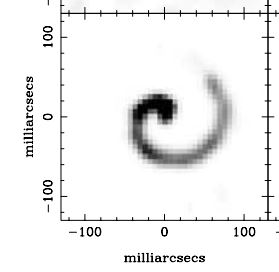More surprises from the Wolf-Rayet star numbered 104 and known for its pinwheel structure

Among astronomers who study such things, Wolf-Rayet 104 is one of the most well known OB massive stars in their catalog, with the infrared picture to the right illustrating why. The star is actually a binary of massive stars, orbiting each other every eight months. Both produce strong winds, and the collision of those winds results in a glorious pinwheel structure that glows in the infrared.
Such stars are also believed to be major candidates to go supernova and in doing so produce a powerful gamma ray burst (GRB) that would shoot out from the star’s poles. As the orientation of this pinwheel suggests we are looking down into the pole of the system, this star system was actually considered a potentially minor threat to Earth. Located about 8,400 light years away, this is far enough away to mitigate the power of the GRB, but not eliminate entirely its ability to damage the Earth’s atmosphere.
New research now suggests however that despite the orientation of the pinwheel, face-on, the plane of the binary star system is actually tilted 30 to 40 degrees to our line of sight. The press release asks the new questions these results raise:
While a relief for those worried about a nearby GRB pointed right at us, this represents a real curveball. How can the dust spiral and the orbit be tilted so much to each other? Are there more physics that needs to be considered when modelling the formation of the dust plume?
You can read the paper here. It is a quite refreshing read, not just because of its relatively plain language lacking jargon, but because of its willingness to list at great length the uncertainties of the data.

Among astronomers who study such things, Wolf-Rayet 104 is one of the most well known OB massive stars in their catalog, with the infrared picture to the right illustrating why. The star is actually a binary of massive stars, orbiting each other every eight months. Both produce strong winds, and the collision of those winds results in a glorious pinwheel structure that glows in the infrared.
Such stars are also believed to be major candidates to go supernova and in doing so produce a powerful gamma ray burst (GRB) that would shoot out from the star’s poles. As the orientation of this pinwheel suggests we are looking down into the pole of the system, this star system was actually considered a potentially minor threat to Earth. Located about 8,400 light years away, this is far enough away to mitigate the power of the GRB, but not eliminate entirely its ability to damage the Earth’s atmosphere.
New research now suggests however that despite the orientation of the pinwheel, face-on, the plane of the binary star system is actually tilted 30 to 40 degrees to our line of sight. The press release asks the new questions these results raise:
While a relief for those worried about a nearby GRB pointed right at us, this represents a real curveball. How can the dust spiral and the orbit be tilted so much to each other? Are there more physics that needs to be considered when modelling the formation of the dust plume?
You can read the paper here. It is a quite refreshing read, not just because of its relatively plain language lacking jargon, but because of its willingness to list at great length the uncertainties of the data.
